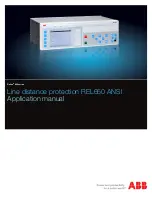
Firmware Design
P846/EN FD/D
MiCOM P846
(FD) 9-9
FD
1.3.5.2
h normally open contacts and two with
changeover contacts. The relays are driven from the 22V power supply line. The relays’
read from using the parallel data bus.
1.3.5.3
fitted to provide an accurate timing
reference for the relay. This can be used wherever an IRIG-B signal is available. The
s connected to the board via a BNC connector on the back of the relay. The
1.3.5.4
r or DNP3.0 protocol on the first rear communications port there is the
hardware option of a second rear communications port, which will run the Courier language.
hysical links: twisted pair K-Bus (non-polarity sensitive),
ut of the second rear
The power supply board incorporates inrush current limiting. This limits the peak inrush
current, during energization, to approximately 10A.
Output relay board
The output relay board holds eight relays, six wit
state is written to or
Depending on the relay model, up to three output relay boards may be fitted to the P846
relay to provide a total number of 32 relay outputs.
IRIG-B board
The IRIG-B board is an order option that can be
IRIG-B signal i
timing information is used to synchronize the relay’s internal real-time clock to an accuracy of
1ms. The internal clock is then used for the time tagging of the event, fault maintenance and
disturbance records.
The IRIG-B board can also be specified with a fiber optic transmitter/receiver that can be
used for the rear communication port instead of the EIA(RS)485 electrical connection
(Courier or DNP3.0).
Second rear communications board
For relays with Courie
This can be used over one of three p
twisted pair EIA(RS)485 (connection polarity sensitive) or EIA(RS)232.
The second rear comms. board and IRIG-B board are mutually exclusive since they use the
same hardware slot. For this reason two versions of second rear comms. board are
available; one with an IRIG-B input and one without. The physical layo
comms. board is shown in Figure 3.
Summary of Contents for MiCOM P846
Page 2: ......
Page 4: ......
Page 5: ...Safety Section P846 EN SS H11 SS SAFETY SECTION...
Page 6: ...P846 EN SS H11 Safety Section SS...
Page 8: ...P846 EN SS H11 Safety Section SS 2 SS...
Page 16: ...P846 EN IT D Introduction MiCOM P846 IT...
Page 18: ...P846 EN IT D Introduction IT 1 2 MiCOM P846 IT...
Page 26: ...P846 EN TD D Technical Data MiCOM P846 TD...
Page 38: ...P846 EN GS D Getting Started MiCOM P846 GS...
Page 58: ...P846 EN ST D Getting Started MiCOM P846 ST...
Page 60: ...P846 EN ST D Settings ST 4 2 MiCOM P846 ST...
Page 78: ...P846 EN OP D Operation MiCOM P846 OP...
Page 104: ...P846 EN OP D Operation OP 5 26 MiCOM P846 OP...
Page 106: ...P846 EN AP D Application Notes MiCOM P846 AP...
Page 108: ...P846 EN AP D Application Notes AP 6 2 MiCOM P846 AP...
Page 122: ...P846 EN AP D Application Notes AP 6 16 MiCOM P846 AP...
Page 124: ...P846 EN PL D Programmable Logic MiCOM P846 PL...
Page 126: ...P846 EN PL D Programmable Logic PL 7 2 MiCOM P846 PL...
Page 144: ...P846 EN MR D Measurements and Recording MiCOM P846 MR...
Page 146: ...P846 EN MR D Measurements and Recording MR 8 2 MiCOM P846 MR...
Page 160: ...P846 EN FD D Firmware Design MiCOM P846 FD...
Page 182: ...P846 EN CM D Commissioning MiCOM P846 CM...
Page 228: ...P846 EN CM D Commissioning CM 10 46 MiCOM P846 CM...
Page 230: ...P846 EN MT D Maintenance MiCOM P846 MT...
Page 232: ...P846 EN MT D Maintenance MT 11 2 MiCOM P846 MT...
Page 238: ...P846 EN TS D Troubleshooting MiCOM P846 TS...
Page 240: ...P846 EN TS D Troubleshooting TS 12 2 MiCOM P846 TS...
Page 252: ...P846 EN SC D SCADA Communications MiCOM P846 SC...
Page 272: ...P846 EN SG D Symbols and Glossary MiCOM P846 SG...
Page 280: ...P846 EN SG D Symbols and Glossary SG 14 8 MiCOM P846 SG...
Page 282: ...P846 EN IN D Installation MiCOM P846 IN...
Page 284: ...P846 EN IN D Installation IN 15 2 MiCOM P846 IN...
Page 296: ...P846 EN IN D Installation IN 15 14 MiCOM P846 IN...
Page 297: ......
















































